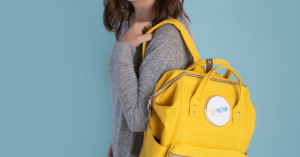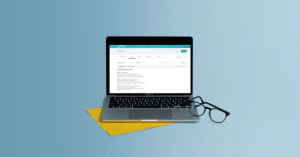Listen on Apple Podcasts Listen on Spotify
Data collection can be a real beast for SLPs.
In this episode of the SLP Now podcast, Marisha shares her best five practices to help you tame that beast — and build a data collection system that works for you.
From setting up intuitive routines to collecting probes to putting the data to work, Marisha’s tips will make data collection easy breezy SLPeasy! 💅
Marisha’s Top 5 Data Collection Tips for SLPs:
1. Develop a Data Collection Routine: By working through the same process in each session, you can find ways to collect the data you need in a really organic and efficient way.
For example, if you are doing a pull-out session, this could mean a quick check-in with students while walking to the speech room or while they get settled in for a session. You can also do things like place their goal cards by the door, so that you can grab them as you walk in and dive right in!
2. Determine How to Use The Data: Marisha recommends making data collection happen at the beginning of the session because it informs her clinical decision making and expectations. It allows her to structure the therapy session around the student’s need, and make better decisions about next steps. In the case of a student targeting an articulation goal, that intial data collection can help you decide if the student needs more teaching or practice — you can tailor the session to meet them where they’re at.
3. Gather Your Probes: The routine Marisha talks about would be difficult to implement without a way to quickly measure your students’ goals. She recommends doing an audit of their goals to make sure you have a way to measure them.
There are so many options for collecting data, and Marisha offers a buffet to consider in this episode! That’s why it’s beneficial to review the goals, and choose probes that make the most sense for the goal you’re targeting.
4. Organize Your Probes: There are so many ways to organize your probes, and Marisha has tried them all! From fancy binder systems with numbered tabs to the digital system she set up in SLP Now, Marisha has tried it all.
In SLP Now, the probes are attached to the goals in the goal bank. When you’re going into a session, the probe you need is just a click (or two) away!
5. Practice Your Routine: Practice makes progress! To really integrate data collection into your session seamlessly takes some time, and that’s okay — you can start slowly, building that routine one step at a time.
Approach your data collection routine with a growth mindset, and scaffold those skills the way you do with your students! It will get easier the more you practice, and soon you won’t have to give data collection a second thought.
✨ Remember: There is no single perfect way to structure a therapy session, and that’s a good thing! It means that you can get creative and be strategic about how you shape your systems and processes. ✨
This episode will give you some ideas to get started, or maybe optimize some of the practices you’ve already got in the works!
And most importantly, have fun! 🙃
Subscribe
Subscribe to the SLP Now podcast and stay tuned for our next series. We’re kicking off September by helping you get your data collection, paperwork, and therapy planning processes in tip-top shape! 💪
Listen to The SLP Now Podcast on Apple ★ Spotify ★ Google ★ Stitcher ★ Castbox or wherever you listen to podcasts.
Transcript
Marisha: Hello there, and welcome to The SLP Now Podcast, where we share practical therapy tips and ideas for busy speech language pathologists. Grab your favorite beverage and sit back as we dive into this week's episode.
Hey there, it's Marisha, and I'm really excited to talk about five tips to streamline your data collection. We will run through the five tips, so let's go ahead and dive right in. The first tip is to develop a routine around your data collection. An example of what that could look like, let's say we're doing pullout therapy, so the students walk in the door and maybe as we're walking to the speech room, we might be doing a quick check-in, or we do that as the students are arriving if they're transitioning independently, and we'll just check in with them to see how they're doing, establish that rapport, all of that. And then I always have goal cards right by the door, and so students also grab their goal cards as they walk into the room. And if I'm seeing students in the classroom, I'll just make sure that I have their goal cards in a folder or just an easy-to-access place where they know where to grab them.
So then every student has a set of goal cards and the students learn that that's just how we start a speech therapy session. They walk in, they grab their cards, they sit down and they start going through their goals. We'll have another episode on this, but their goal cards would include their goal, and this will look different based on the age of the students and the types of goals that they're working on, but they would be able to see what their goal was. It might include why it's important to them, whatever we decide is most relevant, and so they would just be walking through their goal cards, and while they're doing that, I would go ahead and administer a quick probe per student. A probe is just, if you're not familiar with that terminology, it's just a quick little assessment. I typically just include five items.
So, if the student is working on an articulation goal, like initial K for example, I would give the student a little probe where I ask them to say five words that start with the K sound, and then I would just score their accuracy, and that would be student one's goal. Then I would turn to student two, do a quick probe for whatever their target goal is that for that session, and then I would turn to student three, grab their quick probe, and then we would be done with that initial data collection.
That would be an example of my routine. There's not one single way to set up your sessions for successful data collection, but that's what that would look like. We do a quick check-in, the students grab their goal cards, they review them while I collect quick data for one goal per student. Then we would transition into the therapy session, do some awesome therapy, and at the end of the session, I would just recap, I would describe which supports were beneficial. I would describe if I had to do some initial teaching, whatever that might be. So, that's an example of my data collection routine.
Then step two is to determine how you're going to use the data that you collect. I really like to collect my data at the beginning of the session because it really informs me as to how I can best set up the students for success, and it really informs my clinical decision-making. So, for example, the example that I gave of the administering the probe for initial K, if a student is at 0% accuracy with initial K at the word level, I'm not going to expect them to produce K in conversation. I'm not even going to expect them to produce K in words, like using an articulation deck. I'm going to back way up and do some teaching, and I'm going to work on shaping the sound using elicitation techniques.
So, I'm going to back way up, and that feels super, super obvious when it comes to articulation. How nice is it to have that information within the first minute or two of your therapy session and then know exactly how to set up whatever activity you had planned to set up the student for success? This also applies for different goals. So, if we're working on naming items in categories for example, or syntax goals, if we know how a student is performing, we can use that to decide what we do next. So, the example that I gave with 0% accuracy, that would let me know that I need to do some teaching.
This is just a rough range, but let's just say zero to 30% accuracy, more often than not, if that's the accuracy that the student is at, I would start the session with some teaching. Then if they're between maybe 30 to 70% accuracy, that skill is emerging, so I might do a quick review and then give the students the opportunity to practice. Whereas if they're at greater than 70% accuracy on the probe, I want to give them the opportunity to practice. I'm not going to waste time with teaching if they're already starting to demonstrate mastery of the skill. And having this information right off the bat is really helpful because it reminds us to take the time to actually teach and break down skills, and this benefits students because it will reduce that frustration. We're not expecting them to do something that's really difficult. We're meeting them where they're at and giving them the appropriate supports.
But on the other hand, if a student, we might be surprised, we might expect that a student is not making progress on the goal and we might come in, if we don't collect a probe and we just start the session with some teaching and a bunch of review when the student doesn't need it. If we had given them a probe and they'd been at 80% accuracy, we would know that that's essentially a waste of time and the student might get bored. So, having that data right off the bat, again, helps us meet the student where they're at. We're giving the appropriate level of supports, but we're also giving them appropriate opportunities to generalize that skill and demonstrate the ability to do it on their own and facilitate that generalization, because we don't want to have them become dependent on our prompting and support to demonstrate the skill. So, that was step two, just determining how you're going to use that data and how it'll drive your session.
The third tip is to gather your probes. So, the routine that I mentioned would be really difficult to implement if you did not have a way to quickly measure each of your students' goals, and these are just things to consider, so you don't have to implement all of the things that I mention, obviously. Consider it buffet, and you can decide which tips or strategies make the most sense to you. But if you heard me mention tip number three and you're like, "Hmm, I don't know if I have a good way to measure my students' goals," it might be beneficial to take some time to review your students' goals, and maybe even just you don't have to tackle your whole caseload at once.
Maybe if there's a group that feels extra challenging or that you're struggling with more, maybe just start with them. Go through their goals, make sure you have an easy way to measure each of the goals, and then start implementing whatever else makes sense out of these tips. So, that's the third tip, is just to do a quick audit and start making sure that you have a way to assess students' progress towards each of the goals.
Then the fourth tip is to organize your probes. I've seen this be done in a number of ways. I've set up fancy binder systems in the past where I had number tabs for and I kept all of the probes in the binder, and the way that I knew which tab to turn to was, on all of the goal cards, I would write a number. So as the students were creating their goal cards, I would make sure that I had a probe for that specific goal card. Again, I would just write the appropriate number on the goal card, and we would go from there. Whatever goal we're focusing on, I look at that goal card, turn to that tab, and that's how I find the appropriate probe.
In SLP Now, we have probes attached to the goals in our goal bank, so when you go into a session and you click the Data Collection button, you can just click to access a probe. I love that feature because I automatically have probes attached to all of my goals, but the only thing is that a lot of the probes can be administered just with a verbal prompt given the nature of what we do, but some of them do require visual stimulus items, so I still have that binder that I use to keep the visuals and keep those organized. So, you get to decide what makes sense for you in organizing your probes.
Then the fifth tip is just to practice the routine. So, kind of just building that initial routine. Maybe you're not ready to start collecting probes right at the beginning of every session. Maybe that feels a little bit overwhelming, but you can implement having students create their goal cards and reviewing them at the beginning of the session, so that that becomes a known part of the routine, and then you can stack the probes on top of that once that becomes more automatic for you and for them. And when I mention my routine of doing one quick probe per student, I know that a lot of speech therapists, if you're feeling overwhelmed by that and if you're questioning whether that's possible, you're not alone. And that also takes some practice in navigating that. There's some setting expectations with students, there's also making sure that your probes are really organized and that they're easy to access, and that you have one for each of the goals. But this all gets easier and you start to develop resources and strategies to do this in a very, very efficient way.
So, just to recap the five tips. One, develop a routine, then two, determine how you're going to use your data. Then three, gather the probes, four, organize the probes, and five, practice your routine and give yourself grace as you're figuring this out and navigating the process. And then we'll have show notes and resources. There's some visuals and examples at slpnow.com/159. Again, that's slpnow.com/159. That's where you can find the show notes and some supplementary resources.
So, that is a wrap on today's episode. I hope that it was helpful. I'd love to hear from you, and yeah, let us know if you're implementing any of this or if you have any questions. We'd love to hear from you, and we will see you in next week's episode. Thanks for joining us. Thanks for listening to The SLP Now Podcast. If you enjoyed this episode, please share with your SLP friends, and don't forget to subscribe to the podcast to get the latest episode sent directly to you. See you next time.
Sign up to receive email updates
Enter your name and email address below and I'll send you periodic updates about the podcast.




I’m very interested in how you create (or have your students create) goal cards. When will you be sharing more information about this topic?
Thank you!!
Yes! This blog post includes all of the details! https://blog.slpnow.com/student-goals/
Hi! I love your podcast! It’s been so helpful to implement some of your tips in my sessions as a brand new CF-SLP. Do you have an example of what a student’s goal card might look like? Is this something the you make for the students, or do they make it themselves?
Hi Sarah! Thanks for the comment! 💛 This blog post includes more details about the goal cards! https://blog.slpnow.com/student-goals/